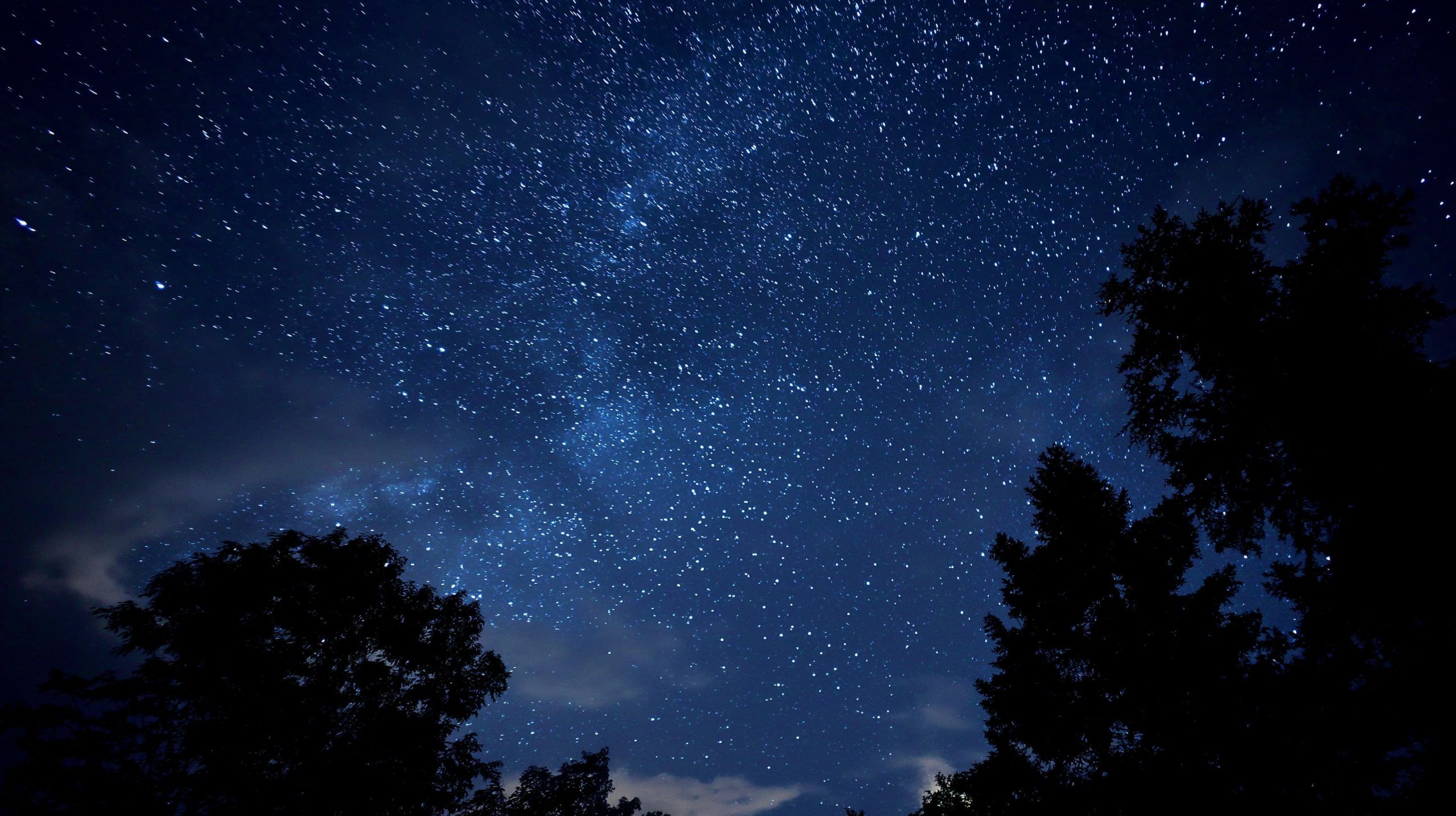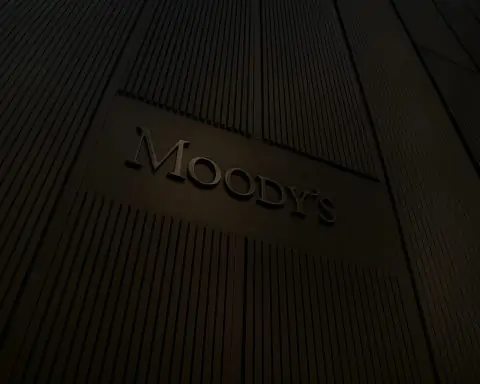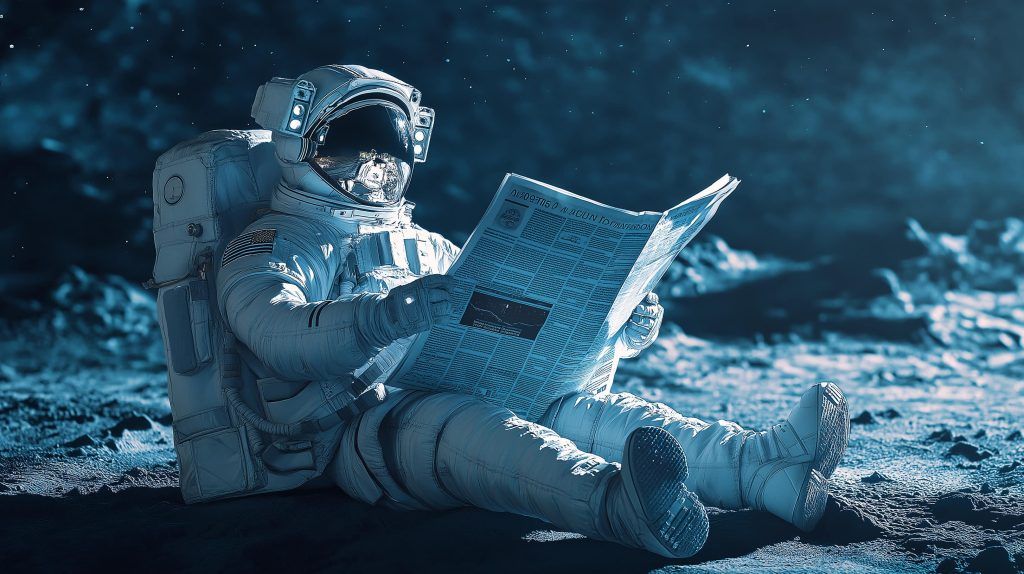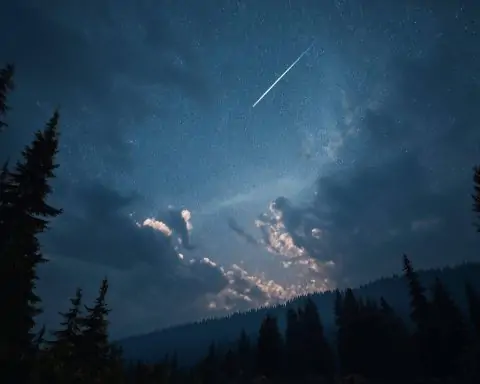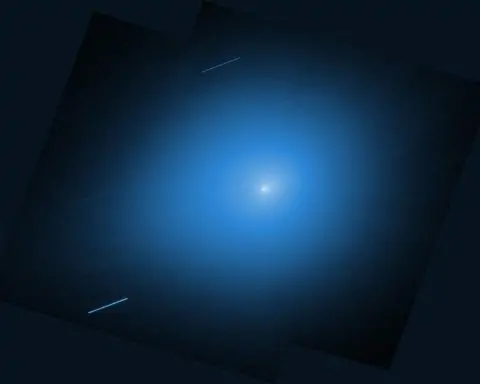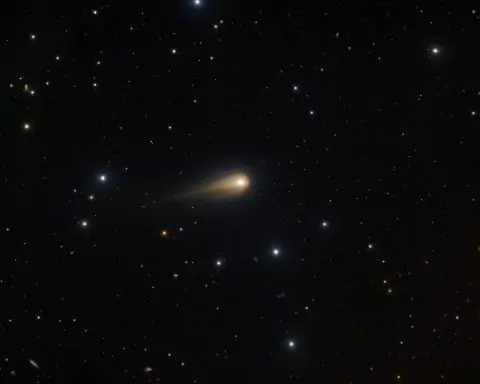- Perseid meteor shower remains active August 14–15, with Moonlight washing out fainter meteors and an expected rate around 10–20 per hour.
- Auroras could appear on August 14–15 due to solar activity, but forecasters expect only mild geomagnetic activity (Kp 5–6, G1–G2) and no major storm.
- Venus and Jupiter form a bright dawn pair around August 14–15, with Venus at magnitude -4 about 20–30° above the eastern horizon and Jupiter nearby.
- Saturn is near opposition later in August, at about magnitude +0.4, bright and high in the southern sky for late-night viewing.
- Mars remains visible in the western sky after sunset, at about 60% of its May brightness and fading as it sets earlier.
- Mercury makes a brief dusk appearance around August 14–15, only about 5–10° above the western horizon.
- Uranus (mag ~5.7) in Aries and Neptune (mag ~7.8) in Pisces/Aquarius are accessible with binoculars or a telescope.
- The International Space Station will produce multiple visible passes around August 14–15, typically near sunrise or sunset as it travels about every 90 minutes.
- The Moon is waning gibbous on August 14–15, around ~80% illumination, rising around 10–11 PM local time.
- Space launches: SpaceX Falcon 9 launches on August 14 from Cape Canaveral at 8:29 a.m. EDT with 28 Starlink satellites, and again on August 15 from Vandenberg at 8:44 a.m. PDT with 24 Starlink satellites.
Get ready for an exciting night sky on August 14–15, 2025. From the tail end of a famous meteor shower to a potential aurora show, and from bright planet pairings to rocket launches, there’s a lot happening overhead. Below is a comprehensive skywatching guide – covering meteor showers, auroras, planets, the ISS, lunar highlights, and even human-made space events – so you can plan your stargazing and not miss a thing.
Meteor Showers: Perseids Sparkle Despite Moonlight
The Perseid meteor shower – one of the year’s most popular “shooting star” displays – is still active on the nights of Aug 14–15 (its peak occurred just a couple days earlier) [1] [2]. Expect to see some Perseid meteors each hour, especially late at night, though bright moonlight will reduce their numbers. In a dark sky without moon interference, the Perseids can produce 50–100 meteors per hour at peak [3]. This year, however, the waning gibbous Moon is washing out all but the brightest meteors, so actual rates could be only around 10–20 meteors per hour [4] [5].
“The average person under dark skies could see 40–50 Perseids per hour… Instead, you’re probably going to see 10 to 20 per hour or fewer, and that’s because we have a bright Moon in the sky washing out the fainter meteors,” explains Bill Cooke, lead of NASA’s Meteoroid Environment Office [6]. Similarly, meteor expert Robert Lunsford of the American Meteor Society estimates that “the best rates will probably be near 15 per hour as dim meteors [will be] hidden in the glare of the 86%-lit Moon.” He advises skywatchers that just after dark you may catch long-lasting “earthgrazer” meteors skimming the atmosphere, “until the moon begins to interfere” later in the night [7].
How to watch Perseids: Find a safe, dark location away from city lights. The best viewing is between midnight and dawn, when the meteor shower’s radiant (in Perseus constellation) is higher [8]. On Aug 14–15, the Moon rises late in the evening (around 10–11 PM), so try looking for meteors in the early night hours before moonrise, and then again in the pre-dawn early morning (keeping the Moon at your back to minimize its glare). Even with the Moon up, some bright Perseid fireballs may still streak across the sky – these meteors, spawned by comet Swift-Tuttle’s debris, can be spectacularly bright and occasionally leave persistent trails [9] [10]. Be patient, give your eyes time to adjust to the dark (at least 20 minutes), and enjoy the late-summer night. The Perseids remain active until August 23, so a few meteors might be spotted even beyond the 15th [11].
(Fun fact: The Perseids are named after the constellation Perseus, from which the meteors appear to radiate. They are bits of dust from comet 109P/Swift-Tuttle burning up in Earth’s atmosphere each year [12].)
Auroras and Space Weather: Will the Northern Lights Dance?
With the Sun nearing the peak of its 11-year activity cycle (solar maximum) in 2025, Earth is experiencing more frequent solar storms – and that means a higher chance for auroras (the Northern and Southern Lights) to put on a show [13] [14]. Auroras occur when eruptions on the Sun (like solar flares or coronal mass ejections) hurl charged particles toward Earth, sparking geomagnetic storms that light up the sky in shimmering curtains of green, red, and purple light. Recently, solar activity has been strong: for example, in May 2024 an extreme geomagnetic storm brought the aurora borealis as far south as Arkansas and California, an incredibly rare sight at those latitudes [15] [16].
What about August 14–15, 2025? Space-weather forecasters at NOAA’s Space Weather Prediction Center did expect a minor to moderate geomagnetic storm (Kp 5–6, G1–G2 level) around August 8–9 from an earlier solar outburst [17] [18]. By the nights of the 14th and 15th, conditions were forecast to settle to quieter levels [19]. No major aurora storm is specifically predicted for Aug 14–15, but this can change on short notice if the Sun erupts again. Keep an eye on aurora alerts – with the Sun so active, surprise geomagnetic storms are possible [20]. High-latitude skywatchers (Canada, Northern US states, Northern Europe, etc.) should be alert for any green glows on the northern horizon on those nights, especially around local midnight, in case of any uptick in solar wind activity.
Experts say we are in an aurora-rich period. “We anticipate additional solar and geomagnetic storms leading to opportunities to spot aurora over the next several months,” says Kelly Korreck, a NASA heliophysics scientist [21]. And as NOAA space weather coordinator Bill Murtagh points out, “The bigger the storm, the more visible the aurora, [and] the further south it’s visible” [22]. In other words, mild solar storms will keep the auroras dancing around polar regions, while really big storms (which are more likely near solar max) can push auroras into much lower latitudes – though those powerful events come with risks to satellites and power grids [23].
For updated aurora forecasts, you can check NOAA’s official aurora outlook maps (e.g. the SWPC Aurora Dashboard at SpaceWeather.gov) which show the predicted auroral visibility oval for each night [24] [25]. If a geomagnetic storm is ongoing, SpaceWeather.com and other astronomy news outlets often report which areas might see the lights. To maximize your chances: find a dark spot away from city lights, look northward (or southward if you’re in the Southern Hemisphere), and be patient. Even if auroras don’t show up strongly on Aug 14–15, the night sky is still full of wonders – from meteors to the starry Milky Way – so it won’t be a wasted trip outside!
Visible Planets and Alignments: A Planetary Pas de Deux
Five planets are on display in mid-August 2025, with some spectacular pairings in the sky:
- Venus & Jupiter – The Brightest Pair: The two brightest planets have been putting on a show in the pre-dawn sky. Around August 11–12 they had an extremely close conjunction (about 1° apart) [26] [27]. By the mornings of Aug 14–15, Venus and Jupiter remain a striking duo, rising together in the east before sunrise. Venus blazes brilliantly (magnitude –4) about 20–30° above the horizon, while Jupiter shines a bit dimmer (but still very bright) just a few degrees away [28]. Look east an hour or two before sunrise to catch Venus (you can’t miss it) and then spot Jupiter nearby – they’ll be the two brightest “stars” in that morning twilight. (Mark your calendar: a pretty celestial grouping occurs a few days later on Aug 19–20, when a slim crescent Moon will join Venus and Jupiter in the dawn sky [29] [30].)
- Saturn – Ringed Jewel of the Night:Saturn rises in mid-evening and is visible for most of the night. In early August it was rising around 10:30 p.m., and by mid-month it’s closer to 9–10 p.m. [31]. By the late night/early morning hours, Saturn will be high in the southern sky. Saturn is nearing opposition (closest approach to Earth) later this month, so it’s shining at one of its brightest points of the year (around magnitude +0.4). Even a small telescope will reveal Saturn’s stunning rings. Look for Saturn in the constellation Aquarius, appearing as a golden “star” that doesn’t twinkle. It will trace from east to west through the night, ending up in the west by dawn [32].
- Mars – Fading in the West:Mars is still hanging on in the evening twilight. You can find the red planet low in the western sky for about an hour after sunset [33]. It’s much dimmer now than earlier this year – only about 60% as bright as it appeared back in May [34] – because Earth and Mars are farther apart. Mars will appear as a modest reddish point, about as bright as the brighter stars of the Big Dipper [35]. Catch it quickly after sunset, as it sets soon and will be tough to see by late evening.
- Mercury – A Challenge:Mercury makes a brief appearance later in August. Around Aug 14–15, Mercury begins to pop up very low on the horizon during dusk in the Northern Hemisphere, but it’s only ~5–10° above the west horizon and might be lost in the sunset glow [36]. By the last week of August it will reach its best evening visibility. If you have a flat, unobstructed horizon (and perhaps binoculars), you might attempt to spot Mercury shortly after sunset in mid-August, but be careful looking too close to the Sun.
- Uranus & Neptune: These distant planets aren’t visible to the naked eye, but if you have binoculars or a telescope, you might locate Uranus in Aries (mag ~5.7) in the late night, and Neptune (mag ~7.8) in Pisces/Aquarius. (Interestingly, Neptune lies not far from Saturn in the sky this month – though too faint to see without optical aid – essentially “together” in Aquarius as Astronomy Magazine notes [37].)
Enjoy the planetary show: The highlight for casual observers is definitely the Venus-Jupiter pairing in the morning. These two planets “grazing” each other in the sky is a relatively rare treat – as NASA notes, they appear closest on Aug 11–12, almost merging into one brilliant point to the naked eye [38]. By Aug 14–15 they are slightly farther apart but still an eye-catching double planet sight. In addition, don’t forget to admire Saturn later at night – late summer is Saturn’s season, and it’s ideally placed for viewing. If you’re up all night, you could see Mars set in the west and a few hours later Venus/Jupiter rise in the east, completing a tour of the planets. (And if you are using a telescope, note that Saturn’s moons offer their own mini-show: for example, Saturn’s largest moon Titan periodically casts a tiny shadow on Saturn’s cloud tops in August, a treat for seasoned observers [39].)
International Space Station & Satellite Flyovers
Keep an eye out for the International Space Station (ISS), which often makes bright flybys overhead at dawn or dusk. The ISS is the largest human-made object in space, and it orbits Earth 16 times a day (one orbit every ~90 minutes) [40]. When conditions are right, it appears as a bright, fast-moving “star” sliding across the sky – usually visible for a few minutes after sunset or before sunrise when the station is still lit by the Sun against a dark sky [41].
On Aug 14–15, the ISS will have multiple visible passes for many locations (visibility depends on your latitude and the ISS’s orbit). All sightings occur within a couple hours of sunrise or sunset – NASA notes this is the optimal window because the station reflects sunlight then but the ground sky is dark [42]. For example, around mid-August, many mid-northern latitude cities will catch morning ISS passes. (Exact times vary: in Warsaw, for instance, early risers on Aug 15 might see the ISS around 4:30 AM local time for a few minutes; in New York a bright pass might occur just before 5 AM – check resources for specifics.)
To find out when the ISS will fly over your area, you can use official trackers like NASA’s “Spot the Station” service or the popular site Heavens-Above [43]. These will give you the time, direction, and elevation to look for the station. As a rule of thumb, the ISS always travels west-to-east (more or less), and it never appears overhead for locations beyond ~51.6° latitude (its orbital inclination) [44]. When you do spot it, it’s unmistakable – the ISS is often as bright as Venus, and it cruises steadily across the stars with no blinking lights (unlike aircraft) and no sudden direction changes.
Aside from the ISS, you might also catch other satellites gliding by. For instance, the Chinese space station Tiangong and SpaceX Starlink satellite “trains” are occasionally visible. A fresh batch of Starlink satellites was launched in early August, so sometimes you can see a line of faint dots moving in tandem shortly after launch (they dim as they disperse). These satellite sightings are an interesting reminder of how crowded low Earth orbit is getting. However, the ISS remains the star of the show – if you’ve never seen it, it’s worth the effort. (Fun fact: at about 28,000 km/h, the ISS will cross the sky in just a few minutes – it’s speeding by much faster than a typical airplane! [45])
The Moon: Waning Gibbous and Nightly Light
Lunar watchers, take note: on August 14–15 the Moon is a waning gibbous, shrinking from about ~80% illumination down toward last quarter. In fact, the Last Quarter Moon occurs on August 16 [46], meaning on the 14th and 15th our Moon is just a couple days shy of third quarter phase. This phase rises late in the evening and is high in the sky by the early morning hours. Moonrise on Aug 14–15 is roughly around 10–11 PM (local time), depending on your location. So the early part of the night will be moon-free and quite dark, whereas after the Moon rises, its bright light will flood the sky.
This timing is a mixed blessing for skywatchers: on one hand, the dark, moonless evening hours right after nightfall are great for stargazing (you’ll be able to see fainter stars, the Milky Way, and maybe some early Perseid meteors before the Moon comes up). On the other hand, once the gibbous Moon is up, its glare will hamper visibility of faint objects – as we discussed, it will wash out many meteors and dimmer stars [47] [48]. If you’re observing then, try to position yourself in the Moon’s shadow or at least keep it out of direct view.
No major lunar eclipses or occultations occur on these dates. The next notable eclipse is still some time away (a total lunar eclipse will happen on September 7, 2025, visible in parts of the world). During Aug 14–15, the Moon will be drifting through the constellations of Taurus and Gemini. In the pre-dawn hours it’s high in the south, forming a pretty tableau with the bright planet Jupiter not far away (though not a close conjunction yet). If you have binoculars, scan the Moon itself – the gibbous phase offers gorgeous views of lunar craters and mountains along the terminator (the line between lunar day and night).
(Lunar phases this month: First Quarter was Aug 1, Full Moon was Aug 9, Last Quarter Aug 16, and New Moon will be Aug 23 [49]. So by mid-month, we’re past the full moon and heading toward the new moon – each night, the Moon rises later and shrinks in phase.)
Other Celestial Highlights: Milky Way Magic and More
Even aside from the headline events above, the summer night sky itself is a spectacle in mid-August. If you’re under a dark sky (especially before the Moon rises), the Milky Way Galaxy splashes across the heavens from south to north. Look for the milky band of light – that’s the glow of millions of distant stars in our galaxy’s disk. Right now the Milky Way’s core (in Sagittarius) is visible in the southwest in the evening, and the Summer Triangle (the bright stars Vega, Deneb, and Altair) is nearly overhead [50] [51]. Within and around this Triangle are numerous star clusters and nebulas accessible to binoculars or small telescopes.
One recommended target is the Dumbbell Nebula (M27) in the constellation Vulpecula. This is a planetary nebula – the remnant cloud from a sun-like star’s death – and it’s one of the easiest of its kind to spot in small telescopes [52] [53]. M27 earned its nickname from its apple-core or dumbbell shape. In a telescope or good binoculars, it appears as a faint gray patch about a quarter the apparent width of the Moon [54]. It lies roughly between Deneb and Altair (within the Summer Triangle) [55]. Observing such an object is like peering 5,000 light-years into the future of our own Sun (which will create a similar nebula when it runs out of fuel in ~5 billion years) [56]. It’s a poignant reminder of the cosmic cycle: stars are born, they shine, and eventually they shed material that will seed new stars and planets – the universe’s endless renewal [57] [58].
If you’re far north, you might also check for noctilucent clouds after sunset. These are ethereal, electric-blue clouds that sometimes linger low on the horizon on summer nights, glowing high in the upper atmosphere. By mid-August the season for noctilucent clouds is waning, but there have been sightings into August at high latitudes in the past. They’re a rare atmospheric phenomenon and would be an extra treat if you catch them. Look low in the northwest about 30–60 minutes after sunset for any strange, bluish tendrils or ripples of light.
In short, even if there were no special events, the August night sky is rich. From the grand sweep of the Milky Way to the subtle fuzz of distant galaxies (like the Andromeda Galaxy rising in the northeast late at night), there’s plenty to appreciate. Bring a star map or an app if you can – you might end up doing an impromptu “Messier hunt” or identifying constellations while waiting for that meteor or ISS pass!
Space Launches and Satellite Reentries: Human Activity in the Sky
Our celestial stage isn’t just hosting natural phenomena – human-made events are happening too on Aug 14–15, 2025:
- Rocket Launches: Space enthusiasts may know that SpaceX has two launches scheduled during this window. On August 14, a Falcon 9 rocket is set to lift off from Cape Canaveral around 8:29 a.m. EDT, carrying 28 Starlink internet satellites to orbit [59]. The very next day, on August 15, another Falcon 9 will launch a batch of 24 Starlink satellites from Vandenberg Space Force Base in California (around 8:44 a.m. PDT) [60]. While these are daytime launches (not visible as a nighttime spectacle for most of us), they are noteworthy – part of an ambitious 2025 launch cadence. If you live near the launch sites, you might catch the rockets’ contrails or hear the rumble. And some early risers in parts of the U.S. West might even notice a brief “string of pearls” of new Starlink satellites in the dawn sky a day or two after launch, before they disperse.
- Other Missions: Just a day before our target nights, United Launch Alliance’s new Vulcan rocket made headlines with its inaugural mission for the U.S. Space Force [61]. And looking a bit ahead, on Aug 21 SpaceX will launch a Cargo Dragon (CRS-33) to the International Space Station [62]. These aren’t directly observable on Aug 14–15, but they add context – it’s a busy season in space! If you follow space news, you might see an extra “star” in the sky that is actually a spacecraft en route (for example, the Dragon capsule catching up to ISS, though that would be faint to spot).
- Satellite Reentries: Intriguingly, a large spacecraft reentry is on the horizon. On Aug 13, China launched a Long March 5B rocket carrying a set of satellites [63]. The core stage of this rocket (about 30 meters long, 20 metric tons) was left in low Earth orbit – and will reenter the atmosphere in a matter of days, uncontrolled [64] [65]. By the nights of Aug 14–15, that massive rocket body will still be circling Earth, gradually being slowed by atmospheric drag. It is expected to tumble back to Earth roughly around Aug 18–19, give or take. Uncontrolled reentries are difficult to predict – even a 1-minute timing error can shift the debris fall zone by hundreds of miles [66]. The Aerospace Corporation and U.S. Space Force will issue forecasts a day or two before reentry, but the exact time and location of reentry will remain uncertain until the last orbits. Notably, astronomer Jonathan McDowell points out that this Long March 5B core is “the most massive object to make an uncontrolled re-entry in decades” (since the 1991 reentry of the Salyut-7 space station) [67]. The practice of leaving such a big object to fall unguided has drawn criticism internationally – NASA and ESA officials have called it an unnecessary risk [68]. Most of the rocket will burn up on reentry, but some pieces (especially dense engine parts) could survive to reach Earth’s surface [69]. The reentry will likely occur over an ocean or uninhabited area (the odds of any one person being hit are extremely low) [70]. Still, it’s a dramatic event to monitor. If reentry happens at night over a populated region, observers could witness a spectacular fireball-like breakup streaking across the sky.
For skywatchers, there isn’t much to see for this until it actually happens – and chances are it will occur far from you. But it’s worth knowing about these events as part of the full picture of human activity in space. If you hear reports of a “mysterious fireball” in mid-late August, it just might be that rocket coming down! For real-time updates, follow sources like NASA, the U.S. Space Command, or reputable astronomers on social media who often share reentry predictions.
In summary, the nights of August 14–15, 2025 offer a bit of everything: a meteor shower sending occasional shooting stars through the waning summer night; a possible auroral glow if the Sun misbehaves; brilliant planets Venus and Jupiter performing a close celestial dance at dawn; the majestic rings of Saturn on display; the ISS sailing by overhead; and even the comings and goings of rockets and satellites reminding us that space is busier than ever. It’s a wonderful time to step outside, look up, and experience the dynamic sky. Whether you’re an avid astronomer or a casual stargazer, these nights have something in store. Clear skies and happy skywatching!
Sources: NASA Watch the Skies blog; NASA Science “What’s Up” skywatching briefing; American Meteor Society; SpaceWeather.com and NOAA SWPC alerts; Space.com astronomy news; Spaceflight Now launch schedule; and other expert commentary as cited throughout. [71] [72] [73]
References
1. www.amsmeteors.org, 2. www.amsmeteors.org, 3. www.space.com, 4. www.nasa.gov, 5. www.space.com, 6. www.nasa.gov, 7. www.space.com, 8. www.nasa.gov, 9. www.space.com, 10. www.space.com, 11. www.amsmeteors.org, 12. www.nasa.gov, 13. earthobservatory.nasa.gov, 14. science.nasa.gov, 15. www.businessinsider.com, 16. www.businessinsider.com, 17. www.space.com, 18. www.space.com, 19. earthsky.org, 20. science.nasa.gov, 21. www.businessinsider.com, 22. www.businessinsider.com, 23. www.businessinsider.com, 24. www.swpc.noaa.gov, 25. www.space.com, 26. science.nasa.gov, 27. science.nasa.gov, 28. science.nasa.gov, 29. science.nasa.gov, 30. science.nasa.gov, 31. science.nasa.gov, 32. science.nasa.gov, 33. science.nasa.gov, 34. science.nasa.gov, 35. science.nasa.gov, 36. science.nasa.gov, 37. www.astronomy.com, 38. science.nasa.gov, 39. www.astronomy.com, 40. www.nasa.gov, 41. www.nasa.gov, 42. www.nasa.gov, 43. www.nasa.gov, 44. www.nasa.gov, 45. www.nasa.gov, 46. science.nasa.gov, 47. www.nasa.gov, 48. www.amsmeteors.org, 49. science.nasa.gov, 50. science.nasa.gov, 51. science.nasa.gov, 52. science.nasa.gov, 53. science.nasa.gov, 54. science.nasa.gov, 55. science.nasa.gov, 56. science.nasa.gov, 57. science.nasa.gov, 58. science.nasa.gov, 59. spaceflightnow.com, 60. spaceflightnow.com, 61. spaceflightnow.com, 62. spaceflightnow.com, 63. en.wikipedia.org, 64. spaceflightnow.com, 65. spaceflightnow.com, 66. spaceflightnow.com, 67. spaceflightnow.com, 68. www.space.com, 69. spaceflightnow.com, 70. spaceflightnow.com, 71. www.nasa.gov, 72. www.businessinsider.com, 73. spaceflightnow.com
